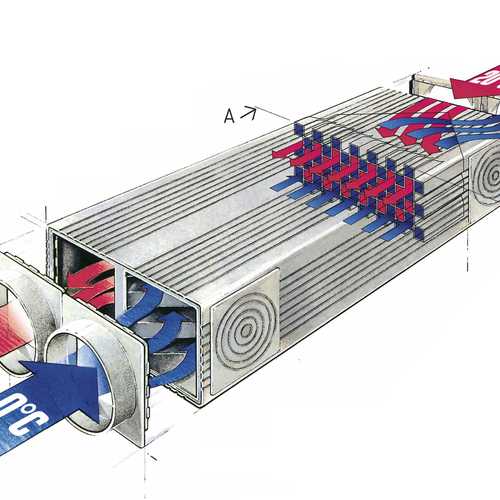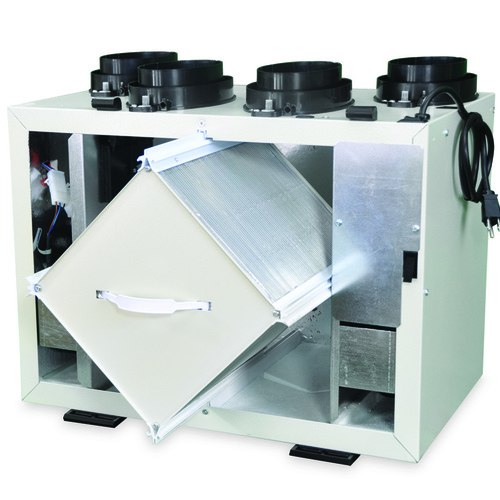
Image Credit: Alex Wilson
Image Credit: Alex Wilson Measuring airflow through a wall register. A flow hood with an anemometer is used for measuring airflow through supply or return registers. Installing the condensate drain on our Zehnder HRV. Assembling the condensate trap for the HRV. An exhaust port for the HRV. A ceiling-mounted air-supply register. This controller, installed in our upstairs bathroom, communicates wirelessly with the main control module. A detail photo of the control modules. There are three programmed speeds, 1, 2, and 3. The clock icon on the lower right allows us to boost the HRV to the highest fan speed for 10 or 30 minutes.
In last week’s blog I described our state-of-the-art Zehnder heat-recovery ventilator (HRV), explaining its various features and specifications. This week I’ll review what should be a critical step in the installation of any HRV: commissioning, including the critical step of balancing the air flow.
This is absolutely necessary to ensure proper operation and full satisfaction from a Zehnder HRV and most other HRVs.
Why commissioning is so important
The ducting runs in a ducted HRV system vary in their air-flow resistance. The two fans in an HRV should maintain neutral pressure — as much outgoing air force as incoming. Otherwise, with negative pressure in the house, radon and other soil gases could be drawn in, or with positive pressure, indoor air could be forced through the building envelope where it could cause moisture problems.
But beyond the two primary fans and pressure-balancing the entire house, the individual registers need to be balanced to ensure that you’re getting proper air flow through each of the supply and return registers. If this balancing step isn’t followed, the HRV might pull a lot more air out of a downstairs bathroom (which is closer to the HRV), for example, than a more distant upstairs bathroom.
Balancing our Zehnder system
Barry Stephens, the Business Development and Technology Director at Zehnder America, came up to Vermont to commission and balance our HRV. I didn’t watch the entire process, but was very impressed at the level of care that he gave to this task.
Barry used a hand-held device to measure airflow through the supply and return registers. This is a small hood that fits tightly over the register with an anemometer (wind gauge) allowing the airflow through the register to be measured in cubic feet per minute (cfm).
The flow through the registers (diffusers) can be adjusted in different ways depending on the type of register. Ceiling-mounted supply registers are adjusted simply by rotating the round, screw-mounted cover plate on the unit, which increases or reduces the gap and the airflow.
Wall-mounted supply registers are adjusted by removing the cover plate and installing an insert that restricts airflow. Different-size disks can be added as needed to further restrict flow.
Exhaust ports are adjusted by moving the center component in or out.
After a round of adjusting, the airflow tests have to be repeated. Every time the flow through one register is changed it affects the airflow through the others. My sense is that there’s a lot of art involved in these adjustments; after balancing hundreds of systems, Barry and others at Zehnder America have a very good feel of how adjusting some diffusers will affect others.
I think for our system all this took several hours, though I’m sure I slowed Barry down with all my questions.
Condensate drain and controls
We realized before Barry arrived to commission our system that the condensate drain had never been hooked up during the installation. Zehnder HRVs have a sophisticated condensate drain with a specialized trap. Barry was able to carry out this installation quickly, though the fact that the trap hadn’t been installed over the previous several weeks meant that moisture got into the heat exchanger core, and this may have caused the frost protection system to work harder that it normally does, increasing electricity consumption.
While the user controls of the Zehnder ComfoAir 350 Luxe are elegantly simple, the behind-the-scenes controls are much more sophisticated — confirmed by paging through the 40-page installation manual (in English) — and I was very glad to be leaving the programming to Barry, though I’ll need to dig into those instructions when I want to change something.
Experience to date
We commissioned the HRV the same day we set up an eMonitor energy monitoring system that allows us to track the electrical consumption of key loads in the house, including the HRV. While in normal operation the HRV uses very little energy, the intermittent frost-protection cycle does use a lot of energy — about 800 watts. During the last ten days of January (a very cold spell), the unit used 65 kilowatt-hours (kWh), while this month (through February 16th) the unit has used 53 kWh.
I love the simplicity of operating the HRV. From either bathroom I can either manually change the speed, or click on a clock icon to boost the unit up to the highest setting for either ten minutes (by tapping the button quickly) or 30 minutes by holding it down for three seconds. (Those times can be adjusted by going into the programming.)
As I noted last week, this isn’t the most affordable HRV you can get, but I feel very good about having what I believe to be the best and most energy-efficient model on the market.
By the way, Eli Gould (the designer-builder of our home) and I will be leading a half-day workshop at the NESEA Building Energy Conference in Boston on Tuesday, March 4, 2014. In this workshop, “What Would the Founder of Environmental Building News Do? Adventures on the Cutting Edge of Green Building,” we’ll be reviewing product and technology choices, describing lessons learned, presenting data on performance, and discussing, in a highly interactive format, some outcomes from this project that can be applied much more affordably in deep-energy retrofits. This should be informative and a lot of fun. I’ll also be presenting in the main conference, March 5-6, on “Metrics of Resilience.” Registration information can be found here.
Alex is founder of BuildingGreen, Inc. and executive editor of Environmental Building News. In 2012 he founded the Resilient Design Institute. To keep up with Alex’s latest articles and musings, you can sign up for his Twitter feed.
Weekly Newsletter
Get building science and energy efficiency advice, plus special offers, in your inbox.















8 Comments
Response to Jonathan Rupp
Jonathan,
You're asking the right questions, for sure. This question was discussed at length in a GBA article, Are HRVs Cost-Effective?
Wow, that looks like a pricy addition
I was thinking about about installing an HRV when i re-do my bathrooms, but your energy consumption seems really high 118 KWH over 25 days?!? That corresponds to an average of 197W, and would be a Huge energy sync in my monthly consumption.
That made me wonder how HRVs would compare vs. just opening your window for a few minutes / hours a day (As i was told to do when i rented an appartment in Germany for 6 months). I have to admit, my thermodynamics are pretty rusty, so someone correct me if i am wrong:
118 KWH / 25 days = 4.72 KWH/day
at my electric prices is Mass: = $0.90 per day in electricity
using my oil prices, that corresponds to 0.242 gal of oil per day
With my boiler efficiency, that is 28.9 k BTU of heating
Assuming you raise the outside temperature 30 degrees (i think the rough average temperature in Mass for a heating day), it takes 0.6 BTU per cubic feet of air to raise the air 30 degrees (i just googled and saw that it takes 0.02 BTU/cubic foot / 1 degree)
That then equates to 48k cubic feet of air movement per day, or 33.5 cfm of air directly from outside, 24 hours per day?
That also doesnt include the capital costs of the equipment, and the labor to install the ducts. Plus i am using an oil boiler instead of the much cheaper natural gas alternative.
I am even rustier on my fluid dynamics of chimneys, but it would seem cheaper to leave my fireplace flue open and crack the windows in my bathrooms when i take a shower.
Does anyone else have any thoughts?
I looked up the chimney flow rate on wikipedia, and assuming 60F interior, 30F exterior, and a 20ft chimney, 33.5 cfm requires a chimny cross sectional area of 5.9 sqft... so i guess to get that much airmovement, i would have to add a window fan infront of my fireplace to blow air up the chimney
Cost of HRV
What is it that makes HRV's in general and the Zhender in particular so expensive?
Response to Jonathan Rupp
I don't have an answer to your question, but it's important to consider possible nuance in the situation. Looking at your calculations, it appears to me that your math assumes a linear relationship between outdoor temperature and the HRV's electrical consumption. Because the HRV is hogging electricity specifically to defrost, answering your question requires knowing the relationship between temperature and the defrost cycle. It seems to me plausible that this is a nonlinear relationship in which increasingly cold temps demand exponentially more time in defrost. For example, if you drop from 30'F to 20'F the defrost time increases by X percent, but when you drop from 20'F to 10'F the defrost time increases by more than 2X percent.
defrost
Defrost cycles i have to imagine in a lot of instances can be done without much penalty using a recirc mode. So this need not be an issue.
The reduced air changes due to the recirc mode should likely be negated during these extreme cold conditions with an increase in stack effect passive air over the average day. Or could be accounted for in total average daily runtime/airflow.
For 50-90w a HRV seems to make sense. It can be installed very economically in most cases - no need to spend almost 10times the cost.
I really dislike the idea of sucking on a house via exhaust only... and then having -5degree air coming in via leaks and/or 'inlets'... :-/ a leaky house is bad... so is one that you put leaks into on purpose. I suppose in mild climates it wouldn't be such a big deal.
Update: energy consumption during February
Our Zehnder 350 has so far used an average of 2.7 kWh per day in February. During months when the defrost function isn't needed, consumption should average less than 1 kWh/day.
Response to Alex Wilson
Alex,
Thanks for the update. That's 112 watts (continuous) for the month of February -- plus the cost of the space heat that leaves your home in the exhaust airstream.
Too Complex
I really don't see this type of installation as being the future of residential ventilation.
A Panasonic spot ERV can be installed for about $600.
Let Fick's Law handle the fresh air distribution. Once the fresh air molecules are delivered, they bounce around the house at about 500 feet per second.
There's a very slim chance that the next owner of the house will maintain a complicated and expensive system since he probably can't even tell if it's not working.
Log in or create an account to post a comment.
Sign up Log in